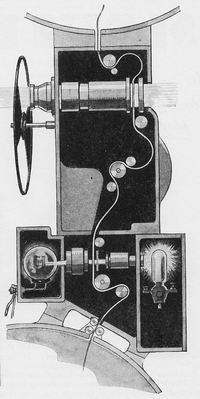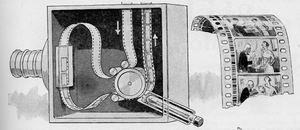Similar to the thermoionic effect
used in the valves, when the light strikes the surface of some
materials it can emit electrons also kown as the photo- emission.
In 1839, Alexander Edmond Becquerel of France observed firstly
the photelectric effect, when he could generate a voltage by
illuminating the junction of an electrolyte.
During the twenties due to the continuous evolution of the valve
technology it was employed in the manufacturing of the first
devices using the photo-electric effect.
Basically in those early devices, the photo emissive layers
were applied to a metal plate, the cathode. It was assembled
inside a glass tube provided also with a second electrode or
anode. In the first devices the emissive material was the Potassium
Hidrate. When the light falls upon the coated plate, the electrons
are emitted from its surface.
The cathode and the anode being connected respectively to the
negative and positve side of a DC power source, the later will
collect the electrons emitted by the cathode. In this way, the
number of electrons is directly proportional to the amount of
light falling on the surface of the coated metal plate.
Due to this assembling arrangement those first devices were
called as Phototubes. They were orignally used in the sound
heads of the early types of sound reproduction system from film
recordings.
However, such kind of sound reproduction systems using phototubes,
later known as photo cells, like sound track sensors devices,
soon were replaced by a more reliable technology - themagnetic
recording. |
 |
a) In the projector
a light source is applied over the sound track.
The modulations are collected by the photo cell
whose signals are amplified and finally are reproduced
by the loudspeaker. |
|
 |
|
How the talkies were made:
a)the microphone in the camera collects the sound
waves converting the same in electrical signals.
|
|
 |
|
Several types of photo-cells
and photo-tubes made in the USA:
a) type 9A, with two anodes and sensitivity of
10 micro A/Lumen
b) type 919, usually used in photometers
c) type 918, gas photo-tube common used in projectors
with a sensitivity of 10 micro A/Lumen
d) type CE-A26, gas foto-tube common used in projectors
|
|
|
|
|
|
|